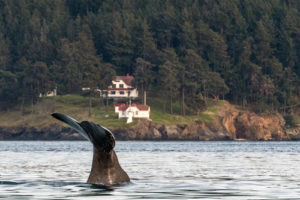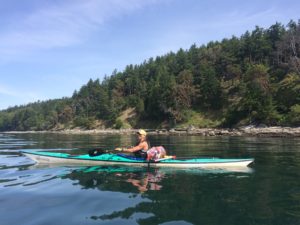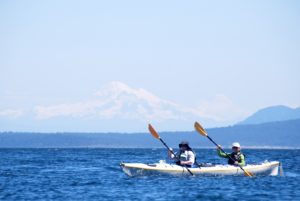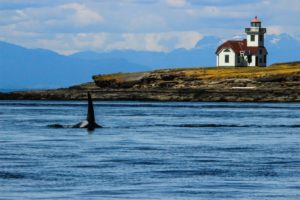Our Unique Island Home
The paddling, hiking, local food and quite town are all a draw for people visiting Friday Harbor and San Juan Island, but the true gem of this outdoor oasis is the wildlife in and around the islands. Whether you’re watching a bald eagle scoop a fish out of the water, getting splashed by Popeye the seal in the harbor, or delighting at the breaching of a young whale, the wildlife of the San Juan Islands never disappoint.
Ever Changing Wildlife
The wildlife here in the Salish Sea sure love to keep us on our toes. For decades it has been the routine if you want to kayak with whales to stay to the West Side of San Juan Island along the “orca highway” and lunch at Whale Watch Park, but that might be changing. 2017 was the first recorded year (observations have been done annually in the summer’s since 1976 by The Center for Whale Research) that our Southern Resident Killer Whales didn’t swim past the Lime Kiln State Park Lighthouse the entire month of August. With a decrease in the number of Fraser River Chinook salmon (the Southern Resident’s primary food source) passing through the Salish Sea, these whales are having to travel farther and be gone longer in search of food.
In contrast, over the last few years we’ve seen a drastic increase in the sightings of Biggs (transient) killer whales around San Juan Island and throughout the Salish Sea. These mammal eaters travel in smaller groups of less than 10 and have been sighted all year round, with over 280 days of sightings in 2017 alone. More prey equals more whales, and with an abundance of marine mammals (seals, sea lions, porpoise, etc) and a threatened population of salmon, this change in whale ecotype sightings does make sense. Are the transients becoming the new residents and the residents becoming transient? It’s not quite that simple, but the wheres and whens of whale watching are definitely changing.
Sea Kayaking & Whale Watching: Both our Day Tour and Multi-Day Tour guests got to kayak with orcas last week as members of our resident J and L Pods surprised these lucky paddlers on their first day spotted in the Salish Sea this summer. Let’s hope they found enough Chinook salmon to stick around!
Not Just Whales – The Many Marine Mammals of the Salish Sea
Not to be forgotten the humpbacks, minke whales, porpoises and sea lions who all are frequently sighted on our paddles, get a lot less attention and notoriety than their orca neighbors, but are just as magical to see!
Guide and Naturalist Jennifer Koenig on her first full day kayak trip of the season recounted, “It was a calm water day so we paddled offshore out in search of some stronger current, when we heard an exhale and turned to see the flash of a small dorsal fin. When it surfaced again we noticed this dorsal had a white tip, alerting us that it was not our normally seen harbor porpoise but the larger and often more timid Dall’s porpoise. There were about 10 total, they swam right under our boats and were porpoising just off our bows!”
Unusual Sightings
Some lucky boaters were treated to a rare sperm whale sighting this spring. Spotted just of Turn Point Lighthouse on Stuart Island where our Multi-Day Sea Kayaking Tours visit. Its wrinkly back and unique angled blow were quite a surprise, having never before been documented in our inland tidal sea.
2015 and 2016 each brought sightings of a fin whale to the waters around the San Juan Islands. This second largest mammal on the planet can grow to over 75 ft long, and the regularly spotted and comparatively small juvenile dubbed “Finnegan” (yes, as in “there’s that fin again”) was still an incredible sighting, with the last regular sightings of fin whales in this area thought to be in the 1930’s. Sighted on an overnight sea kayaking tour, this whale was most accurately described by one of our guides as “well, it looked like a swimming dinosaur.”
How and why ocean conditions are changing and bringing these large whales back to the Salish Sea is still being studied, but it’s a continual reminding that our wildlife is just that: wild.

Shorebirds of the San Juans
It’s not all marine mammals though, with a variety of habitat that includes sweeping prairies, evergreen forests, rocky seashores and brackish lagoons, the San Juan Islands are a birds (and birder’s) paradise.
Migratory shore birds such as the pigeon guillemot, a member of the auk family, have spent this spring nesting on the West Side of San Juan, surprising paddlers as they fly off the rocks overhead. Nesting in the rocky burrows right by the shore, the female will lay one or two eggs, but both parents will incubate. These small birds can dive up to 150 feet by propelling themselves underwater with their wings in search of small fish to bring back to their young, who swallow the fish whole and feed up to 13 times/day. This small, loud bird is a favorite of Full Day San Juan Island Kayak Tour guests, with it’s bright red feet and splashy crash landings.

What You Can Do!
At Outdoor Odysseys we’re always searching for ways to become even better stewards of the environment and support recovery of all the creatures in our marine home. Providing primarily vegetarian meals, composting our food waste, and taking steps to reduce our single use plastic are just some of the ways we’re battling big environmental issues on a small daily scale. As well as supporting groups like The Center for Whale Research that work to protect the endangered Southern Resident Killer Whale population, and add to our knowledge of their behaviors and health. Most importantly, educating our guests about their impact on our marine environment from the water level on a guided sea kayaking tour, helping people get to experience intertidal critters, marine mammals, and a plethora of seasonal birds in their natural habitat in a hands-on, environmentally-sustainable way.

Kayaking and So Much More!
When kayaking the San Juan Islands you never know what wildlife you’ll see on any given day. But between the charismatic marine mammals and nesting shorebirds; the views of the Olympic Mountains and Vancouver Island; the 10 foot tidal exchanges and dynamic currents: paddling here will never disappoint!
